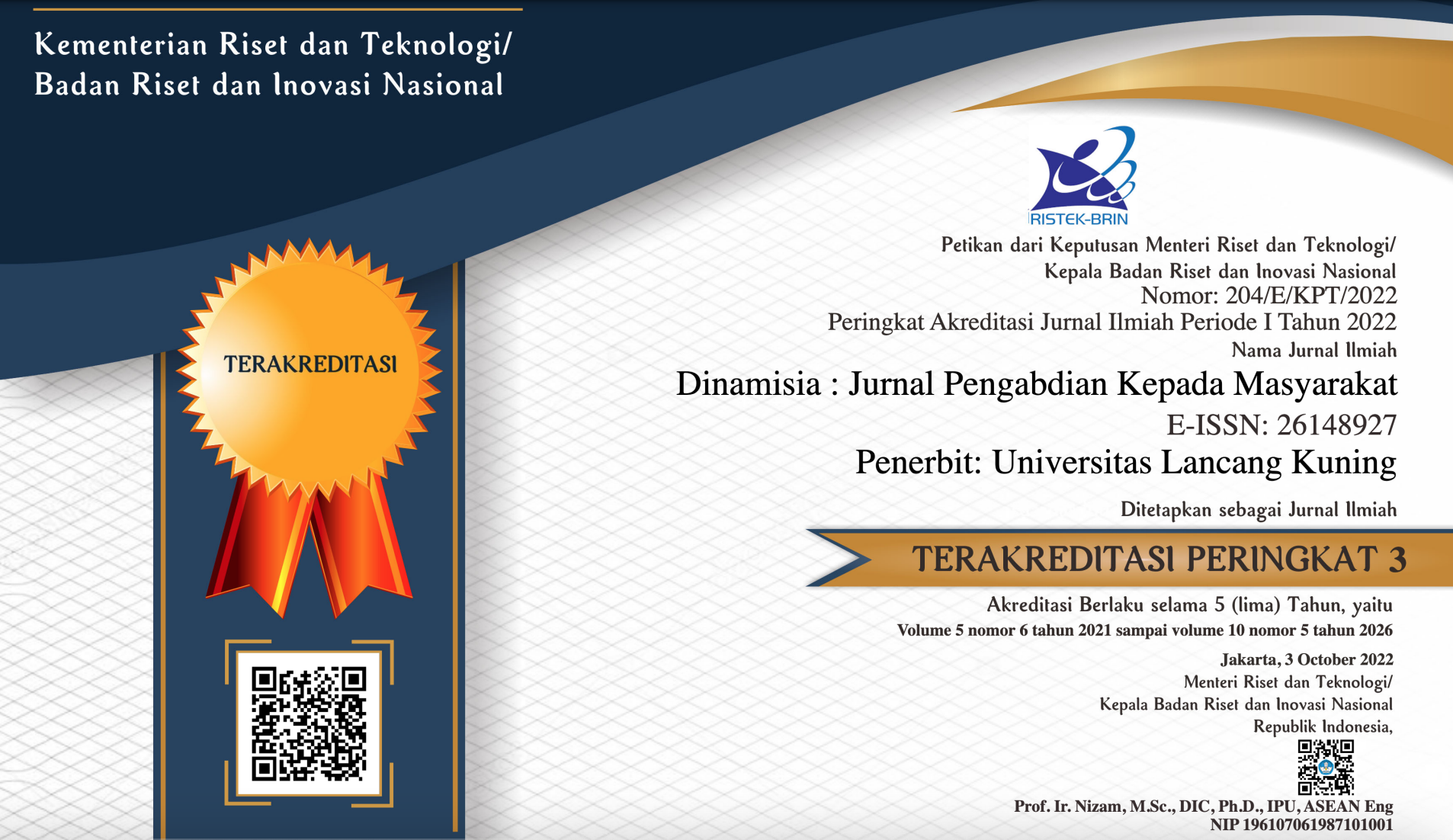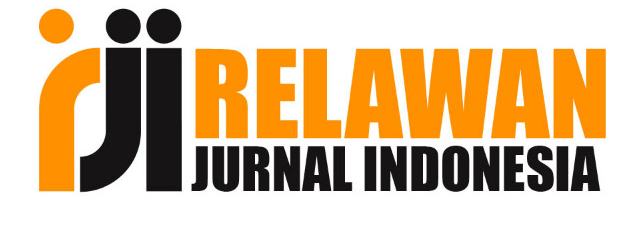Pemberdayaan Forum Guru Muhammadiyah (FGM) Melalui Literasi Digital QR Code Generator dengan Barcode
Abstract
Teacher problems that are the main concern in this community service program are (1) The lack of subject books and subject modules owned by the Muhammadiyah teacher group (2) The low knowledge and skills of teachers and students related to educational technology, especially in making QR-based digital literacy Code Generator with Barcodes. The solution to solving this problem is digital literacy training based on QR Code Generator with Barcodes for Muhammadiyah teacher groups, so that it can make it easier to have subject books and subject modules that teachers can use in learning in the new normal era through gadgets. The implementation method is carried out through four stages, namely (1) digital literacy construction, (2) digital literacy is maintained by the community, (3) improving and updating digital literacy and the resulting changes. The results of community service activities show that the Empowerment of the Muhammadiyah Teacher Forum (FGM) through digital literacy based on QR Code Generator with Barcodes is carried out by involving school principals, teachers and students starting from the socialization stage, the stage of making digital literacy designs, the stage of printing digital literacy designs, the stage of delivering material digital literacy, the stage of training the use of digital literacy, the stage of sharing digital literacy and the stage of using digital literacy QR Code Generator with Barcode. The Muhammadiyah Teacher Forum (FGM) Empowerment activity through digital literacy based on the QR Code Generator with Barcodes received a positive response from school principals, teachers and students because they considered this activity useful and very beneficial.
Permasalahan guru yang menjadi perhatian utama dalam program pengabdian kepada masyarakat ini adalah (1) Minimnya buku mata pelajaran dan modul mata pelajaran yang dimiliki oleh kelompok guru muhammadiyah (2) Rendahnya pengetahuan dan keterampilan guru dan siswa terkait teknologi pendidikan terkhusus dalam membuat literasi digital berbasis QR Code Generator dengan Barcode. Solusi untuk mengatasi masalah tersebut adalah pelatihan literasi digital berbasis QR Code Generator dengan Barcode untuk kelompok guru Muhammadiyah, agar dapat memudahkan memiliki buku mata pelajaran dan modul mata pelajaran yang bisa dipakai guru dalam pembelajaran di masa new normal melalui gadget. Metode pelaksanaan dilakukan melalui empat tahap yaitu (1) konstruksi literasi digital, (2) literasi digital dipelihara oleh masyarakat, (3) memperbaiki dan memperbaharui literasi digital dan perubahan yang dihasilkan. Hasil kegiatan pengabdian kepada masyarakat menunjukkan Pemberdayaan Forum Guru Muhammadiyah (FGM) melalui Literasi digital berbasis QR Code Generator dengan Barcode dilakukan dengan melibatkan kepala sekolah, guru dan siswa mulai tahap sosialisasi, tahap membuat desain literasi digital, tahap mencetak desain literasi digital, tahap penyampaian materi literasi digital, tahap melatih penggunaan literasi digital, tahap membagikan literasi digital dan tahap menggunakan literasi digital QR Code Generator dengan Barcode. Kegiatan Pemberdayaan Forum Guru Muhammadiyah (FGM) melalui Literasi digital berbasis QR Code Generator dengan Barcode mendapatkan respons positif dari kepala sekolah, guru dan siswa karena menganggap kegiatan tersebut bermanfaat dan sangat bermanfaat.
Downloads
References
Agustang, A., Suardi, S., Putra, A. D. M., & Oruh, S. (2021). Pemberdayaan Guru Mata Pelajaran Sosiologi Melalui Literasi Digital Berbasis Quick Response Code di Kecamatan Bissappu Kabupaten Bantaeng. Abdi: Jurnal Pengabdian Dan Pemberdayaan Masyarakat, 3(2), 175–188. https://doi.org/10.24036/abdi.v3i2.120
Atkinson, L. (2013). Smart shoppers? Using QR codes and “green” smartphone apps to mobilize sustainable consumption in the retail environment. International Journal of Consumer Studies, 37(4), 387–393. https://doi.org/10.1111/ijcs.12025
Baban, M. H. M. (2014). Attendance Checking System Using Quick Response Code For Students At The University Of Sulaimaniyah. Journal of Mathematics and Computer Science, 10(03), 189–198. https://doi.org/10.22436/jmcs.010.03.04
Bonifácio, V. D. B. (2012). QR-coded audio periodic table of the elements: A mobile-learning tool. Journal of Chemical Education, 89(4), 552–554. https://doi.org/10.1021/ed200541e
Burnett, C. (2014). Investigating pupils’ interactions around digital texts: A spatial perspective on the “classroom-ness” of digital literacy practices in schools. In Educational Review (Vol. 66, Issue 2). https://doi.org/10.1080/00131911.2013.768959
Chu, L. C., Lee, C. L., & Wu, C. J. (2012). Applying QR code technology to facilitate hospital medical equipment repair management. Proceedings - 2012 International Conference on Control Engineering and Communication Technology, ICCECT 2012, 856–859. https://doi.org/10.1109/ICCECT.2012.31
Durak, G., Ozkeskin, E. E., & Ataizi, M. (2016). QR CODES IN EDUCATION AND COMMUNICATION. Turkish Online Journal of Distance Education, 0(0), 42–58. https://doi.org/10.17718/tojde.89156
Goyal, S., Yadav, S., & Mathuria, M. (2016). Exploring concept of QR code and its benefits in digital education system. 2016 International Conference on Advances in Computing, Communications and Informatics, ICACCI 2016, 1141–1147. https://doi.org/10.1109/ICACCI.2016.7732198
Huang, H. C., Chang, F. C., & Fang, W. C. (2011). Reversible data hiding with histogram-based difference expansion for QR code applications. IEEE Transactions on Consumer Electronics, 57(2), 779–787. https://doi.org/10.1109/TCE.2011.5955222
I Putu, G. S. (2020). Gerakan Literasi Digital Pada Masa Pandemi Covid-19. Stilistika: Jurnal Pendidikan Bahasa Dan Seni, 8(2), 268–283. https://doi.org/10.5281/zenodo.3884420
Karman. (2015). Konstruksi Realitas Sosial Sebagai Gerakan Pemikiran (Sebuah Telaah Teoretis Terhadap Konstruksi Realitas Peter L. Berger). Penelitian Dan Pengembangan Komunikasi Dan Informatika, 5(3), 11–23.
Kikuchi, R., Yoshikawa, S., Jayaraman, P. K., Zheng, J., & Maekawa, T. (2018). Embedding QR codes onto B-spline surfaces for 3D printing. CAD Computer Aided Design, 102, 215–223. https://doi.org/10.1016/j.cad.2018.04.025
Kim, Y. G., & Woo, E. (2016). Consumer acceptance of a quick response (QR) code for the food traceability system: Application of an extended technology acceptance model (TAM). Food Research International, 85, 266–272. https://doi.org/10.1016/j.foodres.2016.05.002
Kossey, J., Berger, A., & Brown, V. (2015). Connecting to Educational Resources Online with QR Codes. FDLA Journal, 2(1), 1. https://nsuworks.nova.edu/cgi/viewcontent.cgi?referer=https://scholar.google.co.id/&httpsredir=1&article=1003&context=fdla-journal/
Kurnia, N., Wendratama, E., Adiputra, W. M., & Poerwaningtias, I. (2019). Literasi Digital Keluarga: Teori dan Praktik Pendampingan Orangtua terhadap ... - Novi Kurnia, Engelbertus Wendratama, Wisnu Marta Adiputra, Intania Poerwaningtias - Google Buku (N. Kurnia (ed.)). Gadjah Mada University Press. https://books.google.co.id/books?hl=id&lr=&id=PWKnDwAAQBAJ&oi=fnd&pg=PA3&dq=Literasi+digital++ADALAH&ots=g7HE4etSCp&sig=BZzFq7oEHfDU3VJDCtsk2kfx4Vg&redir_esc=y#v=onepage&q=Literasi digital ADALAH&f=false
Lai, H. C., Chang, C. Y., Wen-Shiane, L., Fan, Y. L., & Wu, Y. T. (2013). The implementation of mobile learning in outdoor education: Application of QR codes. British Journal of Educational Technology, 44(2), 57–62. https://doi.org/10.1111/j.1467-8535.2012.01343.x
Law, C., & So, S. (2010). QR Codes in Education. Journal of Educational Technology Development and Exchange, 3(1). https://doi.org/10.18785/jetde.0301.07
Law, R. (2012a). Using quick response codes for student interaction during lectures. Annual Conference on Innovation and Technology in Computer Science Education, ITiCSE, 401. https://doi.org/10.1145/2325296.2325417
Law, R. (2012b). Using quick response codes for student interaction during lectures. Annual Conference on Innovation and Technology in Computer Science Education, ITiCSE, 401. https://doi.org/10.1145/2325296.2325417
Lombardo, N. T., Morrow, A., & Le Ber, J. (2012). Rethinking Mobile Delivery: Using Quick Response Codes to Access Information at the Point of Need. Medical Reference Services Quarterly, 31(1), 14–24. https://doi.org/10.1080/02763869.2012.641817
Maheshwari Antosh Dyade, Y. V. B. (2017). Use of Qr Code : a Step Towards Development in India. International Research Journal of Engineering and Technology(IRJET), 4(9), 1126–1129. https://irjet.net/archives/V4/i9/IRJET-V4I9221.pdf
Makasrim, N. A. (2020). Buku Panduan Merdeka Belajar - Kampus Merdeka. https://doi.org/10.31219/osf.io/ujmte
Masalha, F., & Hirzallah, N. (2014). A Students Attendance System Using QR Code. International Journal of Advanced Computer Science and Applications, 5(3). https://doi.org/10.14569/ijacsa.2014.050310
Mawaddah, K., Kusuma Wardani, L., & Sunarmi, D. (2018). PENGEMBANGAN MEDIA INTERAKTIF BERBANTUAN QR-CODE PADA MATERI TUMBUHAN PAKU UNTUK SISWA SMA. Jurnal Pendidikan Biologi, 9(1), 23–30. https://doi.org/10.17977/UM052V9I1P23-30
Nagla, A., Ieda, M. S., & Shaljan, A. (2017). Pre-service Teachers’ Perception of Quick Response (QR) Code integration in Classroom Activities. Turkish Online Journal of Educational Technology, 16(1), 93–100. https://eric.ed.gov/?id=EJ1124922
Nedungadi, P. P., Menon, R., Gutjahr, G., Erickson, L., & Raman, R. (2018). Towards an inclusive digital literacy framework for digital India. Education and Training, 60(6), 516–528. https://doi.org/10.1108/ET-03-2018-0061
Nursalam, Suardi, & Muhajir. (2021). Pemberdayaan Guru Melalui Literasi Digital Berbasis Quick Response Code Quick response Code. MATAPPA: Jurnal Pengabdian Kepada Masyarakat, 4(3), 385–395.
Nursalam, Suardi, Mutiara, I. A., & Herdianty. (2020). Pemberdayaan Masyarakat Desa Melalui Literasi Digital Berbasis Cr Code Di Desa Bonto Jai Kecamatan Bissappu Kabupaten Bantaeng. Jurnal Pengabdian Kepada Masyarakat MEMBANGUN NEGERI, 4(2), 228–238.
Patil, V. V. (2020). APPLICATION OF QUICK RESPONSE [ QR ] CODE FOR DIGITALIZATION OF PLANT TAXONOMY . Journal of Information and Computational Science, 10(1), 1287–1293. https://d1wqtxts1xzle7.cloudfront.net/63331865/4.QR_code_paper20200516-48706-1x5a86z.pdf?1589651268=&response-content-disposition=inline%3B+filename%3DAPPLICATION_OF_QUICK_RESPONSE_QR_CODE_FO.pdf&Expires=1602816543&Signature=ZcbM13EEu3hPadz96hupS-FzUX9yPs
Probst, A. (2012). The Expectations of Quick Response ( QR ) Codes in Print Media : An Empirical Data Research Anthology Number of QR Codes Printed in the Top 100 Magazines ( Jan-Dec 2011 ). UW-L Journal of Undergraduate Research XV, 1–13. https://www.uwlax.edu/urc/JUR-online/PDF/2012/probst.ali.pdf%0Ahttps://www.uwlax.edu/urc/jur-online/pdf/2012/probst.ali.pdf
Pulliam, B., & Landry, C. (2011). Tag, you’re it! using QR codes to promote library services. Reference Librarian, 52(1), 68–74. https://doi.org/10.1080/02763877.2011.521883
Rikala, J., & Kankaanranta, M. (2012). The use of Quick Response codes in the classroom. CEUR Workshop Proceedings, 955(October 2012), 148–155.
Schultz, M. K. (2013). A case study on the appropriateness of using quick response (QR) codes in libraries and museums. Library and Information Science Research, 35(3), 207–215. https://doi.org/10.1016/j.lisr.2013.03.002
So, S. (2011). Beyond the simple codes: QR codes in education. ASCILITE 2011 - The Australasian Society for Computers in Learning in Tertiary Education, 2010, 1157–1161.
Somerall, W. E., & Roche, C. C. (2020). The ABCs of STIs: Promoting student learning using QR codes. Journal of Nursing Education, 59(5), 299. https://doi.org/10.3928/01484834-20200422-15
Suardi, Rukman, A. A., Ramlan, H., Mutiara, I. A., Atmaja, T. S., Sadeli, E. H., Kiptiah, M., Pudjiastuti, S. R., Mathuro, M., & Latief, A. (2023). Pemberdayaan Guru dan Siswa Melalui Literasi Digital Quick Response Code Kurikulum 2013 dan Kurikulum Merdeka Di SMA 11 Pangkep. Jurnal Abdimas Indonesia, 3(1), 63–76.
Suryotrisongko, H., Sugiharsono, & Setiawan, B. (2012). A Novel Mobile Payment Scheme based on Secure Quick Response Payment with Minimal Infrastructure for Cooperative Enterprise in Developing Countries. Procedia - Social and Behavioral Sciences, 65(ICIBSoS), 906–912. https://doi.org/10.1016/j.sbspro.2012.11.218
Susono, H., & Shimomura, T. (2006). Using Mobile Phones and QR Codes for Formative Class Assessment. Current Developments in Technology-Assisted Education, 2, 1006–1010. http://citeseerx.ist.psu.edu/viewdoc/download?doi=10.1.1.129.8360&rep=rep1&type=pdf
Tiwari, S. (2017). An introduction to QR code technology. Proceedings - 2016 15th International Conference on Information Technology, ICIT 2016, 1, 39–44. https://doi.org/10.1109/ICIT.2016.38
Tracey, D. L., DiStefano, T. P., Morris-Hackett, N., & Steefel, L. (2013). Using quick response codes to facilitate self-directed learning in a nursing skills laboratory. Journal of Nursing Education, 52(11), 664. https://doi.org/10.3928/01484834-20131022-12
Traser, C. J., Hoffman, L. A., Seifert, M. F., & Wilson, A. B. (2015). Investigating the use of quick response codes in the gross anatomy laboratory. Anatomical Sciences Education, 8(5), 421–428. https://doi.org/10.1002/ase.1499
Vidas, T., Owusu, E., Wang, S., Zeng, C., Cranor, L. F., & Christin, N. (2013). QRishing: The susceptibility of smartphone users to QR code phishing attacks. Lecture Notes in Computer Science (Including Subseries Lecture Notes in Artificial Intelligence and Lecture Notes in Bioinformatics), 7862 LNCS, 52–69. https://doi.org/10.1007/978-3-642-41320-9_4
Wang, X., Chen, W., & Chen, X. (2015). Optical information authentication using compressed double-random-phase-encoded images and quick-response codes. Optics Express, 23(5), 6239. https://doi.org/10.1364/oe.23.006239
Wongso, O. (2016). QR Code, Face Recognition, and Google Location as Alternative Solution for Employee’s Attendance in Small Companies. Jurnal Teknik Informatika Dan Sistem Informasi, 2(3), 309–318. https://doi.org/10.28932/jutisi.v2i3.506
You, M., Lin, M., Wang, S., Wang, X., Zhang, G., Hong, Y., Dong, Y., Jin, G., & Xu, F. (2016). Three-dimensional quick response code based on inkjet printing of upconversion fluorescent nanoparticles for drug anti-counterfeiting. Nanoscale, 8(19), 10096–10104. https://doi.org/10.1039/c6nr01353h
Zhang, Y., Deng, S., Liu, Z., & Wang, Y. (2015). Aesthetic QR codes based on two-stage image blending. Lecture Notes in Computer Science (Including Subseries Lecture Notes in Artificial Intelligence and Lecture Notes in Bioinformatics), 8936, 183–194. https://doi.org/10.1007/978-3-319-14442-9_16



















